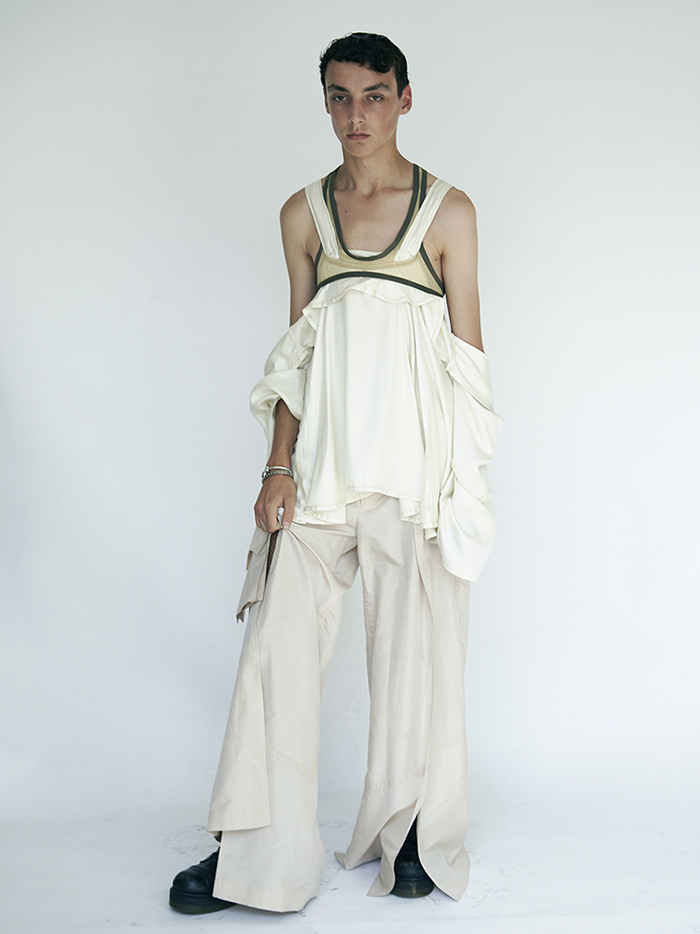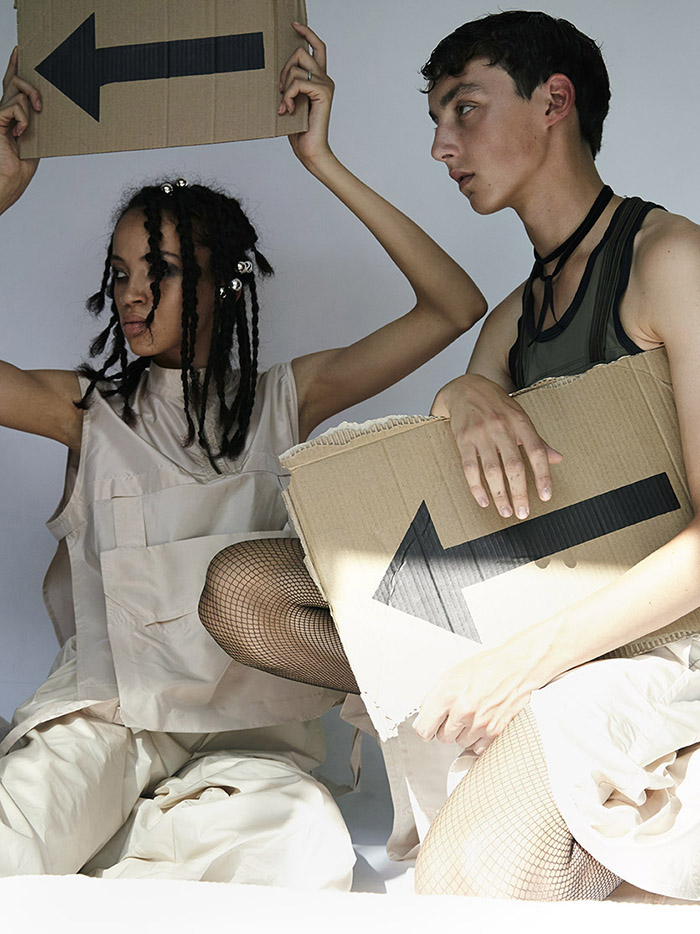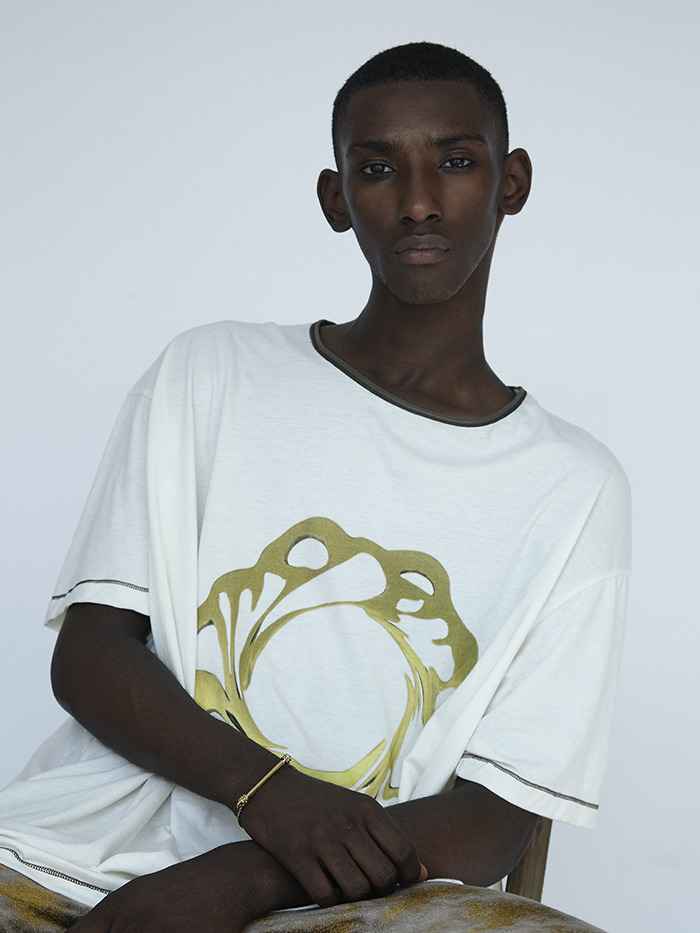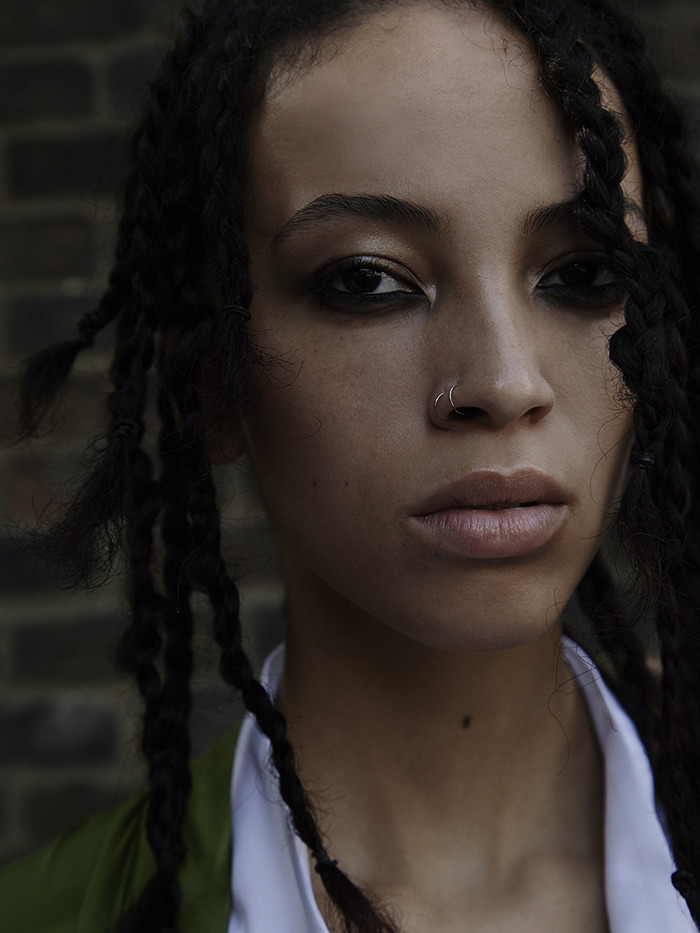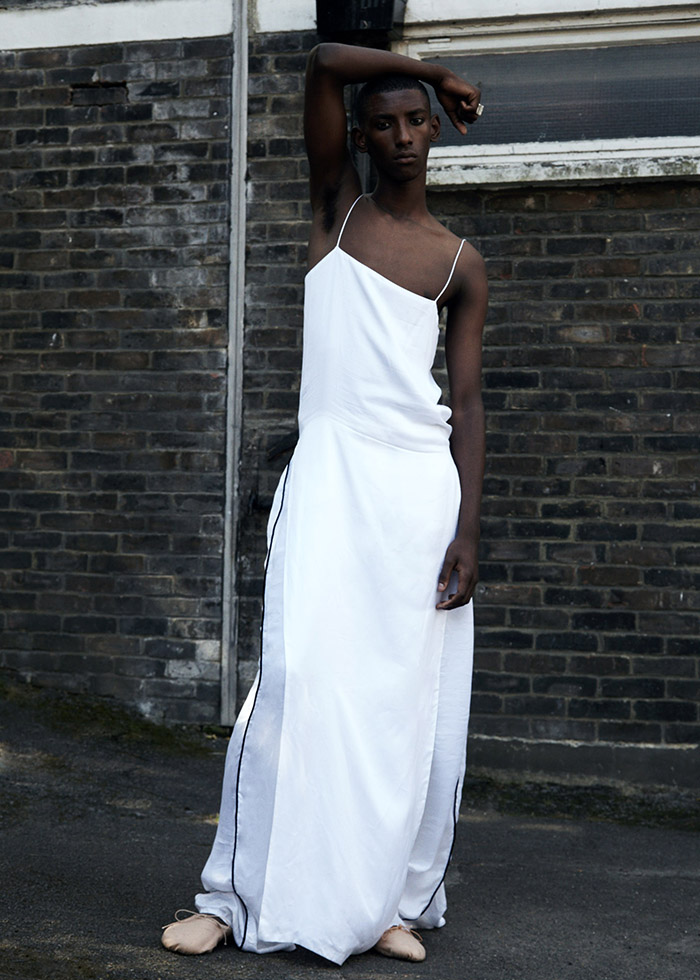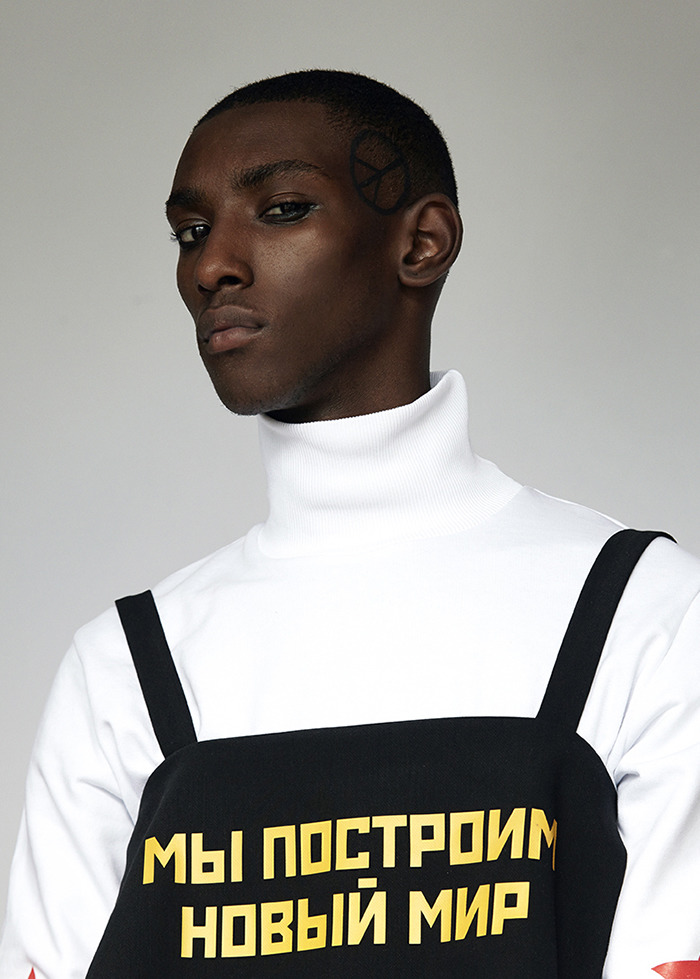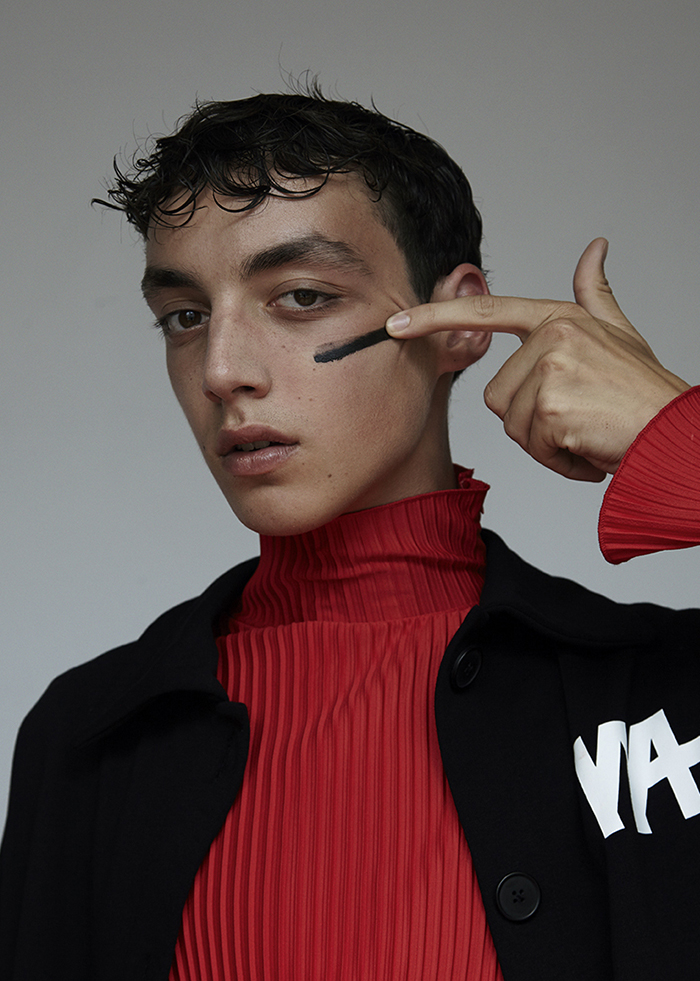The Fabric of Protest
Nazifa Begum, Oummra Collection
All clothes Nazifa Begum, 1 – Brodie wears bracelets Maison Margiela at NET-A-PORTER, Boots at Beyond Retro, 2 – Brodie wears fishnets Jonathan Aston, 3 – Myles wears bracelet Miansai
Nazifa Begum is a young designer who is not afraid to go against the grain. She is part of a wave of young designers who are opening up a dialogue about cultural identity and gender norms, who intend to challenge but not provoke. As a British-Bangladeshi woman, Naz grew up observing the guidelines of gendered dress that her religion impose – “signs of judgement day include ‘men dressing like women or women dressing like men'” – and the fusion of Islamic and Western cultures explored by Western Muslim men, who sport streetwear alongside their traditional thobes to the mosque.
For her debut graduate collection, O ummra, the menswear designer toyed with elements of sportswear but “in a less masculine way” to “keep it away from being too boyish”, and worked with materials that are intentionally political and prohibited in Muslim culture, which subsequently opened her up to criticism. This scrutiny, that includes slut shaming and body shaming, she believes, stems from the fact she is an opinionated woman who has defied expectations of herself.
Here, we spoke to the recent Central Saint Martin’s graduate to learn more about her own rebellion, (as a teenager, as a woman, and as a designer), the film and presentation that followed her runway show featuring a stellar line-up of young creatives, and what she’s currently fascinated by.
Your collection is centred around your interest in your own British-Bangladeshi roots and serves as an exploration into the double lives lead by young British Bangladeshi Muslim men – why did you think of this as an important area to explore?
It was just something I grew up around, and saw those close to me going through. I’m not really trying to make a statement it’s just my reality. It was just mostly lifestyle choices, like the way everyone attended mosque but also (only really the males) were involved in nightlife etc. The girls wore religious clothes but some only in certain situations, and just generally trying to maintain some kind of connection with their traditions but still assimilating to western life.
Style-wise what are the things that are unique as a result of the fusion of these two cultures? How do you explore this as a designer?
The most obvious one would be the mix of sportswear with religious clothing; guys usually wear their best trainers to the mosque, sometimes trackies, but always the long top (thobes some are made already hooded), cap, maybe even a Nike side bag. It’s definitely one of the most iconic looks of those two worlds mixing. I used sportswear elements but in a less masculine way with the use of sports bras, and the trousers were designed to replicate rave style trousers, some with slits down the middle to flash flesh with movement, some made of silk, and some in light pinks, to keep it away from being too boyish. The sandals were Bata, which isn’t traditionally a Bangladeshi shoe brand, but is extremely common there; luckily I had family back home who worked for them and were able to send a batch that were quite typical but clunky/ hard looking.
The collection bares some resemblances to the clothes worn to Hajj, and you chose to work with silk, which isn’t allowed to be worn by men in Muslim culture. Was the use of silk political? And can you tell me a bit about the materials and significance of Hajj clothing.
Other than silk, muslim men are also prohibited to wear gold, but gold wasn’t fitting for this so I used a dirty brass to represent it, whilst still blending with the collection, for the metals. The other fabrics were heavy wax cottons, and even waxy jerseys for dull but not old feel, as well as a nice weight on the body. The slits and open trousers and sleeves were to create movement with the body, and do their own thing. The boxy pockets come from the strap around bags worn to Hajj.
In Islam men are not allowed to wear certain things because they’re considered effeminate. There are strict guidelines when it comes to gendered clothing, so much so that signs of judgement day include “men dressing like women or women dressing like men”. So yeah I guess you could say it was political; it was certainly intentional, and not so that it would provoke or upset, but open up some dialogue about these things, without being too deep or serious.
Tell me about your own rebellion – as a teenager, a woman, and as a designer.
My upbringing was very strict, which made me isolated to those around me, so I wasn’t ever really doing the normal things people do at those ages. I was living on the internet the whole time to be honest, I guess you could say I rebelled there a lot. But it’s more accurate to say I had an extremely late teen rebellion that happened once I’d left home for university, and that I exhausted and got over quickly.
My rebellions as a designer are less to make a point, more because conventional ways don’t work for me. For example doing seasonal collections; I’ve never understood that anyway, and to be completely honest I can’t even keep up with everyone’s A/W’s and S/S’s and pre and cruise collections etc. Maybe one day I’ll get my head around it but right now I just find it all a bit much.
Since the Oummra 2017 presentation I had a lot of negativity that can stem from the fact that I’m female. That included online slut shaming, body shaming, and even criticism to my mannerisms etc. I think most people expect women to be quiet, passive. Being opinionated, and not going hesitating to take control or be dominant, opens you up to so much scrutiny. It’s pretty obvious that had I been a male, all these qualities would be respected, so to defy those expectations of myself, and being focused with what I do without caring about being penalised, is a rebellion in itself.
What is the story behind the collections name, Oummra?
I had a very old book on the occult a long time ago, there was some small weird chart on stars, there was something about the marriage of stars called Oummra; I can’t seem to find that anywhere since though when I’ve tried to look it up. At the time though I thought it was interesting as some people spell the pilgrimage to Mecca like that also. It’s just a word that’s stuck around since, and was fitting for this; spiritual and slightly sinister.
You collaborated with a stellar line-up of young creatives for your accompanying film and presentation which followed your graduate show. How did everyone get involved and how did the concept for the film come about?
The majority of us have been friends for a long time now, so it was all really organic. Everyone’s been involved with each other but never in a project together so I guess that’s what made this particularly exciting. The concept of the film was based around observations I had made of Bangladeshi male interactions with one another; the ones not born in Britain have different boundaries with their friends and are very tactile. We also wanted to portray smaller cultural references, like the black teeth to replicate the eventual stains from chewing betel nut, to henna dipped finger tips but we subverted the practices to appear ritualistic almost horror like. Otherwise it all flowed from the sound track Kamixlo and I made together.
What are your thoughts on the recent progression in gender fluidity within the fashion industry? Do you think that the notion of gendered fashion could be considered obsolete?
Hopefully in the future yes, but right now I think it’s just about slowly diluting the limits of ‘menswear’. I don’t think everyone’s quite ready yet to lose their gender statement through clothes, so fashion won’t be tending to it just yet either, but we’re moving forward.
What do you consider to be the biggest challenges facing you as a young designer in London, do you see yourself staying here?
Mostly financial issues of course. I’m trying really hard right now not to be pushed out completely, but the rent prices and lack of funds is making survival tough.
I was in born in London, spent my childhood here, and the best parts of my life too, so I’d hate to ever leave. I often think about the alternative places to live (like Berlin, or living with family outside of London) that are cheaper and easier but essentially it feels like admitting defeat. A big part of me feels like not allowing myself to be pushed out since I’ve probably more of a right to be here than those doing the pushing. I guess it’s just a matter of finding the ways around it, whether it is through alternative housing, living less central etc etc. I’m trying to see myself staying here for as long as possible.
What is the best part about being a young designer in London?
The people and relationships with each other. Even if they’re not in the same field, everyone feeds in to each other, and the personal relationships seem to come before any work. Most people are incredibly supportive, loyal and impact each others energy. It’s probably the same in most cities, but to me it feels more special here.
Tell me what you’re currently fascinated by?
A current project – it’s something very different to what I’ve worked on in the past, in terms of mediums and techniques. It’s not fashion related at all but is bringing together a lot of talented people again to make something really monumental. When the project is released it will be very obvious, but it’s very much to commemorate the death of an era and the birth of another. It’s hedonistic and spiritual, but as its still very young, I can’t give away too much.
How would you sum up the state of the world today – what hope do you see for the future?
Honestly; quite scary, it feels as though the world is in a very peak place. Maybe some stability.
All clothes DANSHAN, Brodie wears boots stylists own, Myles wears ring Maison Margiela at NET-A-PORTER
Gender boundaries and a reluctancy to conform to traditional values, more than ever, have been at the forefront of fashion over the past year. For emerging menswear brand DANSHAN, this subversion serves as the basis to their work, which rejects traditional values of masculinity in favour of exploring emotions, sensitivity and sensuality.
Headed up by longtime friends and CSM womenswear grads, Danxia, a woman from China, and Shan, a man from Hong Kong, it is their upbringings and what drew them to explore repressive masculinity which makes the duo particularly interesting. Under China’s strict one-child policy (which finally seized to exist last year), that was formidable for its warped gender preferences that shunned a man for not producing a son, Dan was raised as a boy by her father until she hit puberty. Shan, on the other hand, was brought up surrounded solely by women with the void of a father figure, and felt a reluctance to conform to the pressures to act according to masculine archetypes as he grew up.
Following their debut SS17 collection, and as part of our series, Revolt and Resistance, we spoke to the young designers to discuss masculinity, the rebellious undertones to their work and the current climate of fashion and London.
How did you both get into fashion and why did you decide to join forces to form DANSHAN?
We both studied fashion design at Central Saint Martins. We met in first year of university and were flatmates for four years. We worked for the same company before leaving our jobs to start a brand together. We found gender norms for women have moved on a lot, but men are still very much bound to fulfil their more traditional roles; if they don’t, they will be judged and labelled as losers by society. This is a statement that we could both strongly relate to and would like to explore through designing menswear.
How do you guys function as a team – who does what and which techniques and methodologies do you prefer to work with?
It is a partnership and collaboration. We usually start with an emotion that we both find inspirational. Everything else comes naturally within the frame of the specific emotion.
Dan, you were raised as a boy by your dad until the age of 12 because of China’s gender politics – can you tell us a bit about what that was like and how the unconventional upbringing shaped your values and practice as a menswear designer?
I did not think this experience was unconventional, although I tried to run away from it for a long time. I was quite ashamed by it. As soon as I moved to another school, I destroyed all the pictures of me looking like a boy. I had never thought I would ever talk about this experience, but now I felt it helped giving me a different perspective towards gender norms. I have always known that I don’t perceive and expect men in the same way like many others because I had been in a position where I didn’t think it was easy to be a man. As a menswear designer, I would like to design garments for men to explore their emotions, sensitivity and sensuality.
So do you consider your approach to design as rebellious both in relation to your childhood and towards wider gender norms?
You could say it is rebellious towards the gender norms in that it is not bound by the traditional values and following the mainstream masculinity. I don’t think it is rebellious towards my childhood, but inspired by.
Shan, tell us a bit about your upbringing – how has it shaped your values and practice as a menswear designer, and do you consider your approach to design to be rebellious in any sense?
My parents got divorced when I was at a very young age and my mom brought me up as a single parent. Throughout my childhood, all adults around me were female including my mom, her four sisters and my nanny. There wasn’t really a male figure for me to look up to, and I have never felt the need of having one either. As I grew up, many people I got to meet started having expectations from me to act according to traditional value of masculinity, I was very confused and rather reluctant to conform to it. This lead me to the statement we are trying to make through our designs today. You can say it is rebellious with the hope of a better society for both men and women to live in.
As designers do you feel it is important to explore the essence of identity?
We take fashion design as a channel to explore the society we are living in through looking into our personal experiences, so that we could express our point of views with the hope of creating a better and more progressive world.
What is the significance behind the silhouettes and materials you work with for your debut collection and how do they attempt to deconstruct gender binaries?
We made our decisions through looking at how the fabrics draped on the body and felt against the skin. We want to make an impact on the mentality of the wearer of our garments through physical sensations. We always keep an open mind towards fashion without considering its traditional gender boundaries and wished to create sensations and feelings men cannot experience through their usual wardrobe.
What are your thoughts on the recent progression in gender fluidity within the fashion industry? Do you think that the notion of gendered fashion could be considered obsolete?
The progress in gender fluidity was major but we feel that this just touch the surface of how big a concept gender is. No, we don’t think that gendered fashion could be considered obsolete, as DANSHAN, as a brand, we are a menswear fashion brand.
Can you tell me about a book or piece of artwork that has elicited a particularly strong reaction from you recently?
Works by Pina Bausch.
What was the last really beautiful thing you looked at?
Idols by Gilles Larrain.
How would you summarise the current climate for young designers in London and how do you see the brand evolving?
London is a place that allows all kinds of personality to flourish. On the other hand, it is easy for anyone to be drowned out. We are hoping to make a change on social perceptions and traditional values of masculinity, where men will be celebrated for being sensitive, uncompetitive and calm.
All clothes Yulia Yefimtchuk
Yulia Yefimtchuk has been spearheading Kiev’s emerging fashion scene since 2013. Hailed as one of Ukraine’s most radical designers, Yulia creates political fashion, rife with reference to communist aesthetics and the political instability that surrounds her in the Ukrainian capital. Her Cyrillic emblazoned clothes are a silent protest which arrive with a humanistic message, and the intention to highlight important issues in the world – from humans and social life, to love and respect. “Going outside and screaming is not for me”, she tells us. “In each collection I raise the topic that excites me as a person, as an artist, in a way I want to make this world better.”
Working with terse, militaristic silhouettes, the designer – who took home Opening Ceremony’s Honor Award at the Hyères Festivals in 2014, (a prize created especially for her) – creates clothes to conceal the body’s sexuality and to present a woman’s inner world.
For our series, Revolt and Resistance, we caught up with Yulia to question how powerful fashion is as a medium for exploring social and political issues, the contrasts she creates, and what hope she sees for the future.
Tell me a bit about your upbringing and teenage years in Ukraine. How does your heritage influence the brands aesthetic?
Childhood and teenage years I spent in a small town in Western Ukraine. My parents tried to educate me and my sister with dignity, we did not feel any deficit. My father worked as an artist in soviet studios, he made placards with slogans. But my upbringing was traditional Ukrainian with Ukrainian songs, rites and traditions. I was much more influenced by the art of Kasimir Malevich which I discovered in full in Kiev Institute of Applied Arts.
The silhouettes you work with are a stylisation of workwear uniform that are removed from sexuality, what is the significance of these silhouettes – is it political?
I think that explicit sexuality is not sexy. When woman is dressed a bit conservative but her charm cannot be hidden as easily this is beautiful and sexy, it is what my clothes are about. What about politics, it is everywhere – in clothes, in cell phones, in supermarkets…
As the theme for this issue is around Revolt and Resistance, I’d like to ask you about your own rebellion. Tell me about your rebellion as a designer, as a woman and as a creative.
My rebellion is a silent protest. Going outside and screaming is not for me, I protest with clothes, design, it is my art performance. In each collection I raise the topic that excites me as a person, as an artist, in a way I want to make this world better.
Your designs, as you have said in the past, are rife with politics, art and love. What is your political stance and what message do you hope to transmit through your garments?
In politics I am more for socialism, people should be protected in work, in family. It is about social justice, freedom and equality. Clothes that I make bring a positive message, it is important for me as there is enough of aggression all around.
How powerful is fashion is as a medium for exploring social and political issues?
Fashion is a very strong medium for exploring social and political themes as it relates to people with different income level. If one realises why he or she is wearing that clothing, it can help to bring the essence of the idea to a person.
Your collections have drawn influence from soviet iconography and the constructivist art movement – why are these symbolic references and what is it about these periods that have inspired your creative process?
This is the main point while researching to start a collection. I like the precision of words, graphics of posters, cleanness of lines. But that is not enough for me. I am excited by modern music, literature which has no relation to soviet heritage. I look for inspiration in different subcultures and texts that surround me.
You work predominantly in three colours: black to symbolise intellect; red to represent happiness, and white to signify peace. Why do you like to present these contrasts?
I am a calm person inside and clothes help to express myself from the different side. It is easy to use variety of colours, but I am interested to use these three each time anew. This is art experiment.
Can you tell me about a book or piece of artwork that has elicited a particularly strong reaction from you recently?
The last strong impressions I got were from video works of Metaheven and a book of Malevich, manifests and articles on art.
How would you sum up the state of the world today – what hope do you see for the future?
I think that now there is a lot of negativity and disagreements, but in future people will rethink the value of life and will respect and hear each other, money will be secondary.
Photographer: Sarah Stedeford
Stylist: Shirley Amartey
Make up: Bobana Parojcic using Estée Lauder
Hair: Liam Curran
Models: Myles at Supa, Brodie at Models 1, Emily at Elite

